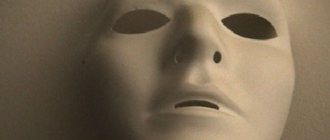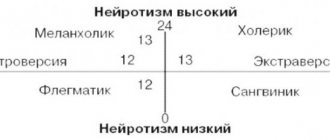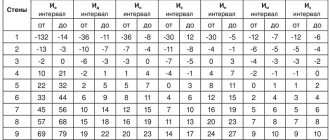Today, many people know that colors have a certain influence on the human psyche. Many problems can be solved by choosing the right color. Proper selection of color combinations will help attract customers to shops and restaurants. A cozy interior can also be created with the right shades. For psychological help, people are given the Luscher test. How to arrange colors correctly? Just as your intuition tells you. The interpretation and analysis of the results of this test show the state of the individual for a given period of time.
Luscher test - child's play or scientific tool?
Of course, it is quite difficult to believe that such a simple diagnostic technique can show reliable results, especially for a person who is far from such a science as psychology. However, the following advantages of this test have been scientifically proven:
- The Luscher test is a rapid diagnostic technique that takes no more than five minutes. In addition, it allows you not to resort to direct questioning of the test taker.
- It is impossible to subjectively influence the result during the Luscher test - this affects both the diagnostic process itself and the processing and interpretation of the results shown. That is, the Luscher test, the answers to which cannot be predicted, is an objective diagnosis of a person’s state.
- Using this method, it is possible to find out the causes and structure of many ailments or their symptoms without consulting an experienced psychologist.
- The Luscher test can reveal both the constitutional characteristics of the patient’s character and his current psychological state.
- This diagnostic technique contains detailed recommendations for the attending physician when used in both homeopathic and psychotherapeutic practice.
- The causes of many diseases, as well as the professional qualities of the person being tested, can be diagnosed by the Luscher test. The description of the results will also reveal many character traits of the subject.
Color mood test results
1. Black . Those who chose black as their favorite color in the picture test are in a fighting mood. You feel incredible confidence in yourself and your strengths, strive for success, and are ready for active action. The negative aspects include the fact that for such people there are no authorities: they can ignore good advice - it always seems to them that no one knows better than them how to do the right thing.
2. Blue . The mood can be called calm. Your soul craves peace, comfort, and deep reflection. People who choose blue as their preferred color can be trusted. They will not deceive, they will not let you down, they will always give practical advice, as they are distinguished by prudence and sound mind. If something is bothering you at the moment, find out how to find peace of mind and not lose yourself .
3. Brown . A person who prefers brown feels insecure about something at a given time. He would really like to realize himself in one direction or another - but the fear of failure holds him back from taking a decisive step. Determine your level of self-esteem using a psychological test .
4. Green. Green lovers are in a light and cheerful mood. I want to communicate, learn something new, amaze others with my charm, perhaps even fall in love. Such a person makes an extremely positive impression on those around him.
5. Gray . This color corresponds to an unstable mood. On the one hand, you want privacy, on the other hand, to be noticed and praised. In general, lovers of gray are reliable, serious people who know their worth. They are loyal and devoted friends, ready to help at the first call.
6. Orange . The mood is friendly. I want to hug the whole world, sing, dance and enjoy life. Such people do not worry about trifles, do not complain about fate, and love big companies.
7. Pink . This color is often chosen by lovers. Of course, their mood is somewhat elevated, they have their head in the clouds, and do not quite realistically assess the events taking place around them. These are very caring, attentive individuals with a passionate temperament and deep feelings.
8. Purple . These people have a restless mood. They want to be in all places at the same time, rushing between different options and opportunities in search of the most suitable one. Often they cannot fully decide on their desires and are left with nothing.
9. Red . The mood of the “red” people is assertive, sometimes even aggressive. These individuals are unbending, go headlong towards their goals, and do not know how and do not want to lose. In addition, they are distinguished by increased sexual energy and often follow their desires. Find out how to learn to control your emotions by following simple recommendations from a psychologist.
10. Turquoise . The mood is mysterious. I want to relax and plunge into nirvana. Or perform a magical ritual. Such individuals have well-developed intuition and can foresee the occurrence of certain events.
11. White . The color of self-expression. If he is chosen, the person is in a mood in which he feels the need to create, to create something new, to generate interesting ideas. White is the color of creative people. It is also associated with purity and honesty.
12. Yellow . The mood is joyful. As has long been noted, yellow is the color of optimists. These are active people who love change. But the main drawback is that they often look at the world too optimistically, not noticing obvious enemies and their insidious traps. “Yellow” personalities are easy to deceive - they believe too much in goodness and in people, even if they have already been deceived more than once.
The fruit of many years of labor
Max Luscher is a Swiss psychologist who created a color test that has gained worldwide fame. Moreover, he did this at the dawn of his scientific career, while still a very young scientist. By the age of 16, Luscher had already developed a solid theoretical base and worked hard on his own scientific works and developments. For example, in the early 1940s, one of the scientist’s hobbies was the creation of an alternative typology of characters.
During his work, Luscher identified color perception as an indicative function of the individual’s psyche, which gives an idea of the character traits, as well as the psycho-emotional state of a person. In the process of this scientific activity, Max Luscher came to the original conclusion at that time that color perception of each person is universal, but emotional perception is purely individual. Based on this, Luscher made the following further conclusion: there is the possibility of using color tests as a diagnostic technique in psychiatry and psychology.
How to pass the mood test
You can take this psychological test almost every day, since our mood, as well as preferences in choosing a shade, change quite often.
Preparing for color testing
The picture below shows 12 different colors, from which you need to choose two that are most impressive, as well as one that you absolutely don’t like. This choice will tell you about the mood at the moment.
It is important not to think about the answer for a long time, not to associate the proposed colors with clothing, nature, or anything else. You just need to instantly decide which color now evokes the greatest sympathy, and which, on the contrary, is rejected. Trust your gut feeling and make a choice.
Find out how much you can trust your intuition in this psychological test .
How to do a picture test
Sit back and take your mind off extraneous thoughts. When you are fully concentrated, follow the instructions.
- First you need to choose the color that evokes the most sympathy and write it down or remember it.
- Of the remaining colors, determine which one you don’t like at all and causes the most irritation - it will be second on the list.
How to decipher the answer
Each color in the test picture describes a particular mood at the time of completing the task. The color declared as the most liked means the presence of these emotions at the current moment in time. The color chosen as a dislike indicates their absence or shortage.
More information about positive, negative and neutral emotions can be found here.
Characteristics of colors according to Luscher
Luscher divided colors into 4 additional and 4 primary. Additional ones are brown (symbolizes stress), gray or zero (symbol of grief), purple (symbolizes anxiety) and black (symbol of worries).
The primary colors are blue, symbolizing calm and contentment, orange-red – symbolizing aggressiveness, willpower, excitement, blue-green, symbolizing stubbornness, confidence and perseverance, and light yellow – symbolizing activity and fun.
Physiological characteristics of flowers
Experiments have proven that when looking at the color orange for a long time, people experienced a stimulating effect, such as increased heart rate, breathing, increased blood pressure, etc. Red color can also have a stimulating effect on the nervous system.
But dark blue, according to the experiment, showed absolutely opposite results: lowering blood pressure, slowing breathing and heartbeat. That is, it has been experimentally proven that dark blue color has a calming effect on the human body in general and on the autonomic nervous system in particular (all complex processes of the body that occur continuously and unconsciously, for example, digestion, heartbeat and lung activity, are regulated by the autonomic nervous system) .
How to take the Luscher test?
According to the test description, choosing one of the four primary colors indicates the desired state of the person, and choosing an additional color will show the actual state of the subject.
The result of the test is the compilation of eight positions, of which the first two show a pronounced preference, the third and fourth - preference, the fifth and sixth - insensitivity to color, and the seventh and eighth - complete antipathy of the test person to color.
During the test, the psychologist writes down the colors chosen by the test subject in the form of a list of numbers in order of preference, while indicating their positions. Interpretation of the obtained values gives results. First of all, the position of the four primary colors is described, with the condition that their position is no further than the fifth. Otherwise, we can conclude that the person being tested has anxieties and unmet needs.
Based on the interpreted Luscher test, as well as when comparing it with questionnaires and conversations with the subject, one can judge his character traits and personality traits.
Diagnosis using drawing
Often psychologists in their practice ask the patient to draw something, and the result is quite effective. Schizophrenics are characterized by incorrect distribution of shadows and an inadequate combination of shades.
- The sun may be black, the trees may be red, the grass may be blue.
- Against the background of a faded picture, a bright flash may be visible, which indicates a one-sided and colorless perception of the world.
- The outbreak should be perceived as an attack. If there is an emotional outburst, the picture will display small inclusions of different shades, while the red color over a large area will indicate a manic state.
- The use of black can be perceived as a sign of fear, difficult experiences and depression.
- Patients use the color red to display images from hallucinations.
- White color indicates the presence of religious delusions and corresponding thematic hallucinations.
Rorschach test
The essence of this test is revealed by the ink technique. The author is Hermann Rorschach, a Swiss psychologist. The patient is shown one by one 10 cards with color and black and white images in the form of ink blots without a clearly designated shape of a specific object.
The test taker must describe what he sees - the image, the whole picture, the movement of objects and their interaction. The popularity of this technique is due not only to determining the full picture of mental pathologies, but also to obtaining answers to many personal questions.
Requirements for colors
Psychologists believe that the Luscher color test must be carried out in natural light, and in no case under the light of indoor lamps. In this case, direct sunlight should not affect the color chart. The full Luscher test must be carried out exclusively using original cards measuring 8 by 8 centimeters. Otherwise, the material for the test is considered unsuitable.
However, studies have shown that the Luscher color test can be carried out from a computer monitor, but it must be taken into account that each device has its own color rendition.
Advantages and disadvantages of the Luscher test
Unconscious processes dictate the choice of color - this is the basis on which the Luscher test rests. The correct choice of color is based on who a person is, and not on how he sees himself or wants to become, as is most often the case with other survey methods.
Proponents of the Luscher test as a method for diagnosing a person’s psychophysical state argue that this survey method allows for a deep and at the same time quick analysis of personality based on information obtained from the usual ranking of color cards.
Luscher color test technique, results processing, children. Adaptation study using the Luscher method
Expert review:
The Luscher test is based on an experimentally established relationship between a person’s preference for certain colors (shades) and his current psychological state. The Luscher test is characterized by the fact that it can give a deep and extensive, and free from the conscious control of the subject, characterization of his psychological state in a short time (time of implementation - less than 10 minutes).
Lack of scientific evidence
Areas of use:
This technique can be used:
When studying the child’s comfort level at home, in the garden, at school;
When identifying the emotional attitudes of preschoolers in relation to the upcoming school education;
When diagnosing a family situation;
To identify the child’s relationship to school during the adaptation period;
To identify individuals prone to depression and affective reactions.
General description:
This test consists of stimulus material (eight color cards) and a methodological manual, which contains a description of the test, testing procedure, numerical indicators and their calculation, processing, interpretation of results and answer forms. Interpretation tables make it possible to simplify the processing of test results as much as possible. The procedure for ranking color cards (from the most pleasant color to the most unpleasant) allows you to calculate the total deviation from the autogenic norm (SD) and the vegetative coefficient (VC).
Time: 5-8 minutes.
Guidelines:
the experimenter shuffles the colored cards and places them with the color surface facing up in front of the subject, after which he asks him to choose the one he likes best out of eight colors, i.e., select the most pleasant color out of eight. The experimenter puts the card with the chosen color aside, turning the color side down, and writes it down on the answer form. The color selection procedure is repeated. If the subject cannot choose the most pleasant color, the experimenter offers to choose the most unpleasant color and writes it down on the form at the very bottom. After 2-3 minutes, the experimenter repeats the study: he again lays out the cards with the color side up and invites the subject to choose his preferred colors again, explaining that the subject should not remember the layout order in the first choice or consciously change it.
Quantitative processing of the results is carried out using formulas and is correlated with the interpretation of the test results described in the methodology.
Based on the work of Wallneffort, a certain order of color selection (34251607) was adopted as an autogenic norm - an indicator of psychological well-being. To calculate the total deviation from the autogenic norm (SD), it is necessary to compare the order of places that colors occupy in the child’s choice with the “ideal” arrangement (34251607). First, the difference between the actual occupied space and the standard position of the color is calculated, then these differences (their absolute values, without taking into account the sign) are summed up. The CO value varies from 0 to 32 and can only be even. The CO value reflects a stable emotional background, i.e., the prevailing mood of the child.
The vegetative coefficient (VC) characterizes the energy balance of the body: the ability to consume energy or the attitude towards saving energy. The calculation of VC is carried out according to the formula proposed by K. Shiposh.
When using this test in work with school students, it is necessary to pay attention to the following features: if a child has an emotional, non-constructive attitude towards school, then several hypotheses should be tested: you need to ask the child what color his mood is like in individual lessons ( mathematics, reading, etc.), since rejection of school may be caused by difficulties in mastering a subject (for example, a child cannot read, has bad handwriting, etc.).
If the child feels fine in class, then the reason for the negative attitude towards school may be problems in communication. You should ask the child what color his mood is like when he plays with the guys at recess or talks with the teacher.
If the child is anxious or the parents are overly fixated on school success, then he may be afraid to answer at the board in front of the whole class. To test this hypothesis, you need to ask the child what color his mood is like when he answers at the board during lessons. Such a more detailed diagnosis allows us to specify the reasons for emotional rejection of the school and outline the direction of further work with the child.
The Luscher color test can be used individually.
Additional description:
Projective methodology for personality research. Based on subjective preference for color stimuli. Published by M. Luscher in 1948.
The stimulus material for the test consists of standard multi-colored squares cut out of paper with a side of 28 mm. The complete set consists of 73 squares of various colors and shades. Usually an incomplete set of 8 colored squares is used. The primary colors are (in order of number assigned to them) blue, green, red, yellow, and the secondary colors are purple, brown, black and gray (zero). A simplified examination procedure (for eight colors) comes down to the simultaneous presentation of all colored squares on a white background to the subject with a proposal to choose the one he likes the most, which is pleasant. The selected square is turned over and set aside, then the procedure is repeated. A series of squares is formed in which the colors are arranged according to their attractiveness to the subject.
The first two colors are considered clearly preferred, the third and fourth are preferred, the fifth and sixth are neutral, and the seventh and eight cause antipathy and a negative attitude.
The psychological interpretation of the resulting series of subjective color preferences is based, firstly, on the assumption that each color has a certain symbolic meaning, for example: red - the desire for power, dominance, green - perseverance, perseverance. Secondly, it is believed that the range of color preferences reflects the individual characteristics of the subject. In this case, the position occupied by a specific color has functional significance. For example, it is believed that the first two positions of the series determine the individual’s goals and ways of achieving them, and the last two are the suppressed needs symbolized by these colors. The choice in the field of primary colors is associated with conscious tendencies, and among additional ones - with the sphere of the unconscious.
In the personality theory developed by M. Lüscher, there are two main psychological dimensions: activity-passivity and heteronomy-autonomy.
Foreign studies devoted to this technique note the speculative nature of its author’s theory and the need for detailed scientific development of the test. Data on the validity and reliability of the test are mixed. Along with individual examination, group examination is allowed.
In domestic studies, the validity of the Luscher color test was studied (I. M. Dashkov and E. A. Ustinovich, 1980), and the connections between color choice and emotional state were investigated (N. K. Plishko, 1980).
An attempt was made to develop, based on this test, a methodology designed to study the emotional components of a person’s attitude towards people significant to him and himself (A. M. Etkind, 1980). Research by N. N. Pukhovsky (1995) is devoted to the psychometric development of L. c. V. t. (8-color version). According to this researcher, the test “triggers” the neuropsychological mechanisms of categorical color perception. It is assumed that in the traditional testing procedure, the relative position of some pairs of colors in an 8-position row is not random; their combination without repetition obeys the law of normal distribution and reflects the patterns of functioning of psychological mechanisms that form the current mental state and stable personality characteristics. Data are presented that confirm the hypothesis, and it is concluded that the test is sensitive to the slightest changes in the current state, and can also be useful for studying personality characteristics. students of grades 1 - 2 S/K/OU
Study of adaptation using the Luscher method - determining the emotional state of a child at school, the presence of positive and negative emotions in various educational situations. The child's emotional self-esteem is revealed.
The psychologist lays out colored cards in front of the child on a blank sheet of A4 paper in random order.
Instructions
1. Look carefully and answer the questions: which of these colors is your mood most like when you go to school in the morning? Most often, usually. Name it or point it with your finger. 2. What about at home on weekends? 3. Which of these colors most resembles your mood when you are sitting in class? 4. And when do you answer at the board? 5. And before the test or test? 6. When do you play or communicate with the guys during recess? 7. When do you talk to the teacher?
Now choose from these colors the one that you like best, which seems more beautiful than the others (the psychologist removes the card chosen by the child). And of the rest? (remove the card chosen by the child again, etc.).
Determining a child’s emotional attitude towards school situations
When choosing blue, green, red, yellow colors, a positive attitude, attitude, emotional state, and good mood are noted. When choosing black, a negative attitude, negativism, a sharp rejection of what is happening, and a predominance of bad mood are noted. When choosing a gray color, a neutral attitude, lack of emotions, passive rejection, indifference, emptiness, and a feeling of uselessness are noted. When choosing a brown color, anxiety, restlessness, tension, fear, and unpleasant physiological sensations are noted (stomach ache, headache, nausea, etc.). When choosing the color purple, infantilism, whims, instability of attitudes, irresponsibility, and maintaining the “child’s position” are noted.
Determining a child’s emotional self-esteem
If the child’s general color choice begins with blue, green, red, yellow, then in this case the child’s self-esteem is positive, he identifies himself with good children. If the general color choice starts with black, gray, brown, then in this case the child has a negative self-esteem, he identifies himself with bad people, and does not like himself. If the general color choice begins with purple, then in this case the child has infantile self-esteem, personal immaturity, and maintains attitudes and behavior patterns characteristic of a younger age.
Interpretation of results
| Violet | Brown |
| Color location is ok | |
| The place of color in a child’s choice | |
| Difference |
ES = 2 + 6 + 1 + 3 + 0 +1 + 3 + 2= 18
20 - predominance of negative emotions. The child is dominated by a bad mood and unpleasant experiences. A bad mood indicates a violation of the adaptation process, the presence of problems that the child cannot overcome on his own. The predominance of a bad mood can disrupt the learning process itself, but indicates that the child needs psychological help.
10 - emotional state is normal. The child can be happy or sad, there is no reason for concern, adaptation proceeds generally normally.
0—predominance of positive emotions. The child is cheerful, happy, optimistic, and in a state of euphoria.
Analysis
If a child chooses brown, gray colors in all seven cases and purple in situations “well-being at home, general attitude towards school, relationship with the class teacher” - 0 points are given.
If you choose black color - 1 point.
When choosing blue, green, red, yellow - 1 point.
High level of adaptation:
The child’s answers are scored 6-7 points - the child’s overall emotional attitude towards school is positive.
Average level of adaptation:
answers are scored 4-5 points - it is possible to display a negative attitude both towards the school as a whole and towards individual aspects of the educational process.
Low level of adaptation:
answers are scored 0-3 points - the child has a predominantly negative attitude towards school.
The emotional state of the child at school is analyzed separately.
Color test of emotional states
Determination of a child’s mood in class is carried out using a color test of emotional states based on the Luscher test. A child’s bad mood, difficult relationships with a teacher or peers can affect the success of his activities.
For diagnosis you will need 8 colored squares, which are shown in the figure.
The child is asked to choose a square that is similar to his mood during class, and then a square that is similar to his mood during communication with the teacher. Next, for comparison, you can invite your child to choose a color that is similar to his mood at home, in kindergarten, when he communicates with his mother, friend, etc.
We offer you an interpretation of color choices and color associations. Of course, you should correlate the results obtained with your observations of the child during classes or the observations of the teacher.
Blue color
— this color is chosen by calm, sensitive children. Their mood is generally positive, although there is some sadness. The child has a need for a deep, understanding interlocutor, for individualized communication. Classes where there is no personal contact with the teacher are not comfortable for them, they withdraw into themselves and feel sad.
Green color
- this color is chosen by children with a high level of aspirations. They feel the need to be first, the need for praise. It is also important for them to be treated with respect by teachers and peers; they love to be set as an example to others.
Red color
— this color is preferred by energetic, active children. They like to make noise, play pranks, and can be the ringleaders in games. The color shows that the child is in a good, active state during classes.
Yellow
means that the child expects only good things from classes and is inclined to listen to the teacher and follow his instructions.
Purple
- the color of too childish behavior, the need for care, praise. The child may not maintain distance in relationships with adults; if the demands are too strict, he may become capricious and throw a tantrum. Overall the mood is positive.
Brown color
- the color of anxiety, discomfort, not only emotional, but also physical. The child may have a headache, stomach ache, or feel nauseous. The child may worry that his achievements do not meet the expectations of the teacher or parents.
Black color
- this color is chosen by children who do not like what is happening in class, they express their protest, rebel, and do not obey the demands of adults. This is a state of open conflict with a teacher or peers, or with the activity in which they have to engage.
Grey colour
- the color of passive rejection. A gray mood means that the child is bored in class, that he is indifferent to what is happening, does not delve into the process, and ignores the teacher’s instructions. Often this happens because the child does not see the point in classes, since he cannot fulfill the requirements.
Thus, blue, green, red, yellow and purple colors indicate the child’s emotional well-being, while brown, black and gray indicate distress. Based on the interpretation of color and observations of the child’s actions and behavior, you can understand how comfortable the activities are for him.
Luscher test: how to arrange colors correctly?
The method created by Luscher is one of the most beloved among psychologists. The top three also include Cattell and Eysenck tests. In addition, this test is very often unreasonably used to select people. Why? Because it often gives a lot of useful information about a person in a short time. And it is unreasonable because the full Luscher test is a diagnostic technique not for personality traits, but for its condition. It has been experimentally proven that after a few months people arrange colors completely differently. It is necessary to select people based on characteristics that are stable over time, for example, intelligence.
In addition, it will not be difficult to bypass the Luscher test. How to arrange the colors correctly is all you need to remember. There is a perfect sequence of eight colors.
There are a large number of interpretations of the Luscher test. Therefore, if you do not want to appear in the eyes of a psychologist as a pregnant woman, an alcoholic or a drug addict, then it is better to arrange the colors in a close to ideal sequence. This will serve as a kind of safety precaution.
So you take the Luscher test. How to arrange colors correctly? The correct sequence is red, yellow, green, purple, blue, brown and black. Also remember that the cards used for the Luscher test have peculiar shades.
It is better not to take risks and not to arrange colors in an ideal sequence, since it is well known to psychologists and is called the “autogenic norm”. It will be better if you swap the colors a little. Ideally, the primary colors should come first - from red to blue, and then additional ones. You can swap places, for example, yellow and red. Under no circumstances should you move blue to sixth place! You can change it with purple.
Meaning of colors
Colors in psychology color tests have meanings that indicate personality traits:
- Red - determination, desire for self-expression, strong will.
- Yellow - activity, cheerfulness.
- Blue - calmness, the desire for calm.
- Green - confidence, perseverance.
- Purple is a combination of determination and peace.
- Brown - guidance of feelings.
- Gray - the desire to hide from the outside world.
- Black - denial of the joy of life, a negative outlook on life.
The colors used in the test are divided into primary and secondary. The main ones include red, yellow, blue, green. The rest are considered additional.
If you have passed the Luscher psychological test on colors online and realized that you need specialist advice, you can contact psychologist-hypnologist Nikita Valeryevich Baturin.
Main rules
When placing flowers, you should adhere to several rules:
- During the 2nd pass of the psychological test with flowers, do not copy the first layout.
- Place primary colors in the first positions, additional colors in the last.
- Stick to the rules, but respond according to your feelings too. If you answer dishonestly on a color test with a psychologist, there is a chance that this will come out in a personal interview. Then you will find yourself in an awkward position.
The desire to make a good impression, forgetting about your real qualities, will not always be a plus. Some employers value employees who can be themselves. The main rule here is that everything should be in moderation.











